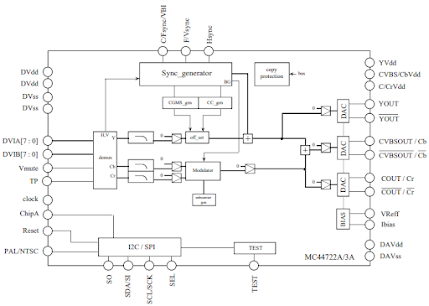Digital Video Encoder:
The digital video encoder is a device that can
encode video and deliver it in a digital format. Digital video is the
representation of digital images that are known as frames in rapid succession.
Every image comprises pixels each pixel is unique due to its color. Encoding a
color is not a challenging task due to color code.
The workings of a Video encoder is flowing a stepwise approach.
- The first step is to capture a video.
- Captured video is now ready for the encoding process, video encoding can be achieved with the aid of hardware or a software utility. In the case of software, MATLAB and some other tools are available. In the case of hardware variety of approaches can be utilized.
Few digital encoders are as advanced as the MC44722
and MC44723A the modules perform the conversion of ITU-601/656 parallel data
into an analog video format. Advanced digital video encoders are embedded in
the internal architecture of television. Digital encoders receive a digital
signal from the main tower and convert the signal into an analog signal to be
formatted into a television format.
The internal circuit consists up of many Digital to analog converters and signals reception circuitry. The internal circuit of the MC44722A and MC44723A is presented in its data model given below:
In the figure above, the main components are; the Sync Generator, Modulator, SPI, Digital to analog converters, and the registers. The unique feature of the module is its lack of dependency on external adjustment. For video systems, some key features are the NSTC, PAL, mute level, and contrast. MC44722A module is equipped with the mentioned controls. However, for activating these control no external circuitry is required. The reset procedure is dependant upon the clock pin that controls its de-assertation. This de-assertation is important for latching the status of other adjustment pins such as Vmute, NTSC/PAL, and SEL. Whilst also having the control registers being managed by the adjustment pins. Sample latching is performed on the input data format. The next step is demultiplexing, the color filter, and filtration of the samples. The module is equipped with a digital to analog converter for the conversion of processed signals into the analog format.
The improvements in the technology can be highlighted by mentioning previous research work. The few listed applications are; Ultra-Low Power Adaptive Wavelet Video Encoder with of Integrated Memory, Low-Power Video EncoderlDecoder Chip Set for Digital VCRs, and A PAL/NTSC digital video encoder on 0.6-/spl mu/m CMOS. Advancements are made based on the SNR, Phase information, Size, differential gain, and frames per second. So the figure of merits for the selection of digital video encoder is differential gain, SNR, Phase information, and frames per second. Another merit is its cost-effectiveness usually the module with the least requirement of external circuitry is considered to be the most cost-effective.
Encoders are classified based on the output video formats and encoding schemes. Several video formats are available for the videos such as MP4, MOV, WMV, FLV, AVI, ACCHD, WEBM, and MKV. Some of the video encoders such as ADV7175/ADV7176 offer the facility of video. The reception of the video depends upon demodulator and de-compressors. The analog signal is dependent upon the digital encoder. Whilst the choice of the digital encoder is made based on the bits per frame capacity and application requirements.




Comments
Post a Comment